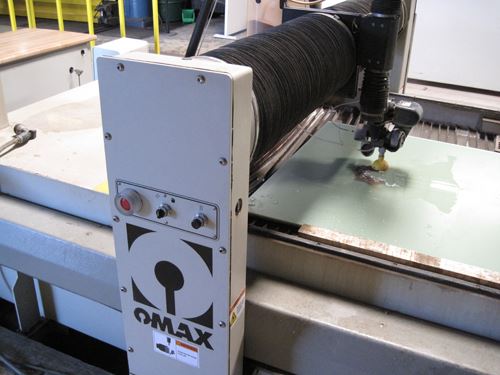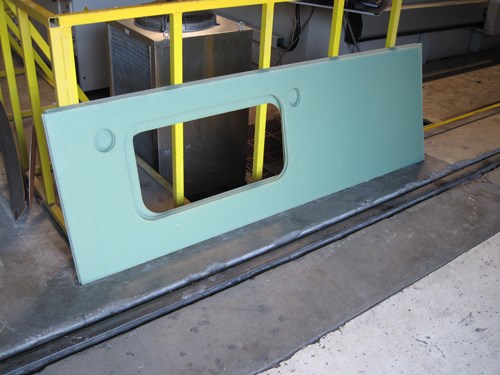Cutting train doors with precision
GFMI Aerospace & Defense uses waterjet cutting technology to produce glass fiber/epoxy door panels for a major rail car manufacturer.
GFMI Aerospace & Defense (Fountain Valley, Calif.), as its name implies, is used to working with composites in high-performance applications, but occasionally it also handles the type of job that, although demanding, is targeted toward mass transportation markets. Such was the case recently when general manager Adrian Corbett was approached with task of cutting hundreds of glass fiber/epoxy panels for use in the manufacture of train doors for a global passenger rail car manufacturer.
The doors, comprised of two 7 ft by 2 ft (2.1m by 0.6m) panels that slide away from each other to allow passengers to get on and off the train, posed a challenge in that each one had to be cut to meet precise dimensions, before bonding to an aluminum exterior panel.
GFMI, says Corbett, chose as its raw material standard 5-mm/0.2-inch thick G10 glass fiber/epoxy panels provided by Interstate Plastics (Sacramento, Calif.) that measure 4 ft by 8 ft (1.2m by 2.4m). From each panel GFMI would cut two door halves, or one complete door. The question was how to cut it.
GFMI opted for waterjet cutting, and for the job has relied on its OMAX Corp. (Kent, Wash.) 60120 55,000 psi waterjet machine. The company stacks four sheets into its OMAX and cuts all simultaneously, starting with interior features first — 15-inch by 30-inch (381 mm by 762 mm) window and cutouts for door handles — before cutting perimeter features.
Corbett says the waterjet process provides door panels with clean edges at the cuts, with none of the dust associated with traditional composites machining. It takes GFMI about 3.5 hours to machine four sheets, after which GFMI makes and installs glass into the windows, bonds the composite to the aluminum and delivers finished product to the customer for final assembly.
As of January 2013, GFMI had manufactured about 400 door sets, with more on order.
Related Content
-
ASCEND program update: Designing next-gen, high-rate auto and aerospace composites
GKN Aerospace, McLaren Automotive and U.K.-based partners share goals and progress aiming at high-rate, Industry 4.0-enabled, sustainable materials and processes.
-
Composites end markets: Automotive (2024)
Recent trends in automotive composites include new materials and developments for battery electric vehicles, hydrogen fuel cell technologies, and recycled and bio-based materials.
-
Cryo-compressed hydrogen, the best solution for storage and refueling stations?
Cryomotive’s CRYOGAS solution claims the highest storage density, lowest refueling cost and widest operating range without H2 losses while using one-fifth the carbon fiber required in compressed gas tanks.














